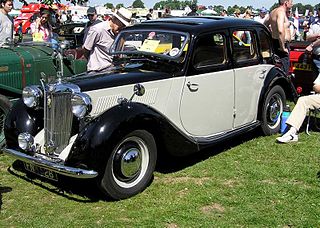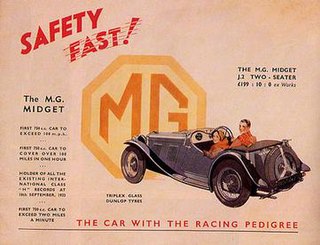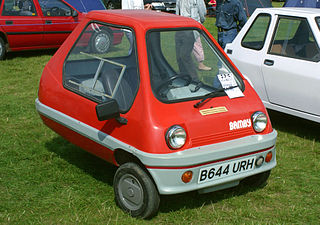
Alvis Car and Engineering Company Ltd was a British manufacturing company in Coventry from 1919 to 1967. In addition to automobiles designed for the civilian market, the company also produced racing cars, aircraft engines, armoured cars and other armoured fighting vehicles.

Berkeley Cars Ltd of Biggleswade, Bedfordshire, England produced economical sporting microcars with motorcycle-derived engines from 322 cc to 692 cc and front wheel drive between 1956 and 1960.

The Holden Gemini is a compact car that was produced by Holden and sold in Australasia from 1975 to 1986. It was based on the Japanese Isuzu Gemini, one of the many models based on the GM T-car platform.

The Triumph Herald is a small two-door car introduced by Standard-Triumph of Coventry in 1959 and made through to 1971. The body design was by the Italian stylist Giovanni Michelotti, and the car was offered in saloon, convertible, coupé, estate and van models, with the latter marketed as the Triumph Courier.

The MGA is a sports car that was produced by MG from 1955 until 1962.

The MG T-Type is a series of body-on-frame open two-seater sports cars that were produced by MG from 1936 to 1955. The series included the MG TA, MG TB, MG TC, MG TD, and MG TF Midget models. The last of these models, the TF, was replaced by the MGA. Although the design was similar to contemporary cars of the 1930s, it came to be considered outdated by the 1950s.

The Toyota Carina is an automobile which was manufactured by Toyota from December 1970 to December 2001. It was introduced as a sedan counterpart of the Celica, with which it originally shared a platform. Later, it was realigned to the Corona platform, but retained its performance image, with distinctive bodywork and interior — aimed at the youth market and remaining exclusive to Japanese Toyota dealerships Toyota Store. It was replaced in Japan by the Toyota Allion in 2001 and succeeded in Europe by the Toyota Avensis.

The MG Y-Type is an automobile produced by MG in England from 1947 to 1953. It was offered in four-door saloon and limited production open four-seat tourer versions.

The MG J-type is a sports car that was produced by MG from 1932 to 1934. This 2-door sports car used an updated version of the overhead camshaft, crossflow engine, used in the 1928 Morris Minor and Wolseley 10 and previously fitted in the MG M-type Midget of 1929 to 1932, driving the rear wheels through a four-speed non-synchromesh gearbox. The chassis was from the D-Type with suspension by half-elliptic springs and Hartford friction shock-absorbers all round with rigid front and rear axles. The car had a wheelbase of 86 in (2,184 mm) and a track of 42 in (1,067 mm). Most cars were open two-seaters, but a closed salonette version of the J1 was also made, and some chassis were supplied to external coachbuilders. The open cars can be distinguished from the M type by having cut-away tops to the doors.

The Riley Nine was one of the most successful light sporting cars produced by the British motor industry in the inter war period. It was made by the Riley company of Coventry, England with a wide range of body styles between 1926 and 1938.
The SA was Toyota's first new passenger car design after World War II. It was the first in a family of vehicles before the introduction of the Crown. A series of light trucks also shared the chassis and major components of these passenger cars.

The Alvis Three Litre Series III sports saloon or drophead coupé, also known as TE 21, is an automobile produced by English manufacturer Alvis between 1963 and 1966 with a body built by Mulliner Park Ward. It was an updated version of the 1958 TD21.
The Hampton was a British car made by the Hampton Engineering Company which was based in Kings Norton, Birmingham from 1912 to 1918 and at Dudbridge in Stroud, Gloucestershire from 1918 to 1933

The Alvis Fourteen also known as TA 14 was the first car to be produced by major defence contractor Alvis cars after World War II. The entire car factory had been destroyed on the night of Thursday 14 November 1940. Announced in November 1946 it was made until 1950 when its postwar austerity 1900 cc engine was replaced by the 2993 cc 26.25 HP Alvis Three Litre or TA 21.

The Alvis Three Litre series IV, TF21, an updated version of the 1963 TE21, was the last car produced by Alvis Cars, having been announced at the Geneva Motor Show in March 1966 it remained in production until 1967.

The Alvis Speed 20 is a British touring car that was made between late 1931 and 1936 by Alvis Car and Engineering Company in Coventry. It went through four variants coded SA to SD.
The Marlborough was a make of car sold on the British market between 1906 and 1926. For most of its life the cars were made by Malicet et Blin in France, but after World War I they were partially assembled (finished) in London and an increasing number of British parts used.

Bamby Cars was a British-built marque of microcars produced in small numbers in Hull, England, in the early 1980s. Bambys were designed and built by Alan Evans, who manufactured a one-off replica of the Peel P50 which also served as a prototype for further production.

The Alvis Firefly is a car manufactured by Alvis from 1932 until 1934. It followed on from the 12/50 TJ model.

The Fiat Pininfarina Cabriolet was a two-door, two passenger, front engine rear drive convertible manufactured by Pininfarina, and marketed by Fiat across two generations, superseding the Fiat 1200 Spider.






















